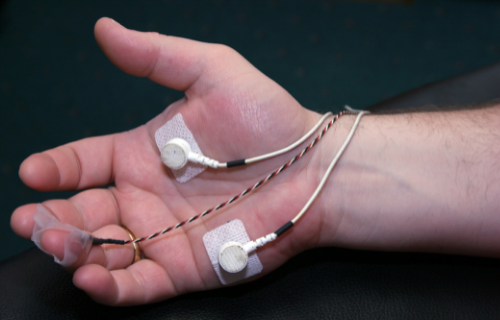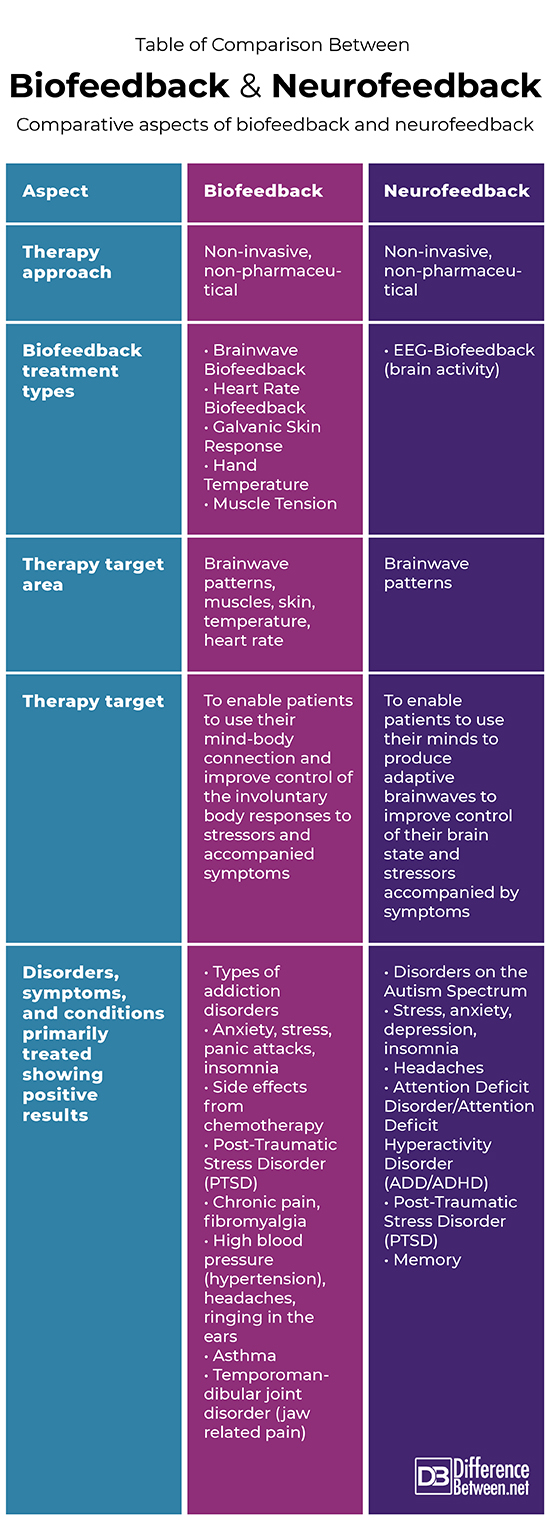Difference Between Biofeedback and Neurofeedback
Introduction
Both biofeedback and neurofeedback (a type of biofeedback) are defined as non-invasive treatment methodologies which are used and applied to various disorders. The treatment protocols specifically focus on this and include no drug treatment, thus being non-pharmaceutical. The overall goal of biofeedback therapy is to reach a level of long-term symptom relief for patients suffering ailments and disorders brought on by bodily stressor responses.

What is biofeedback?
Definition
Biofeedback is a type of training which aims to relieve stress-related health disorders through a non-invasive, non-drug nor pharmaceutical technique.
How Biofeedback Works
During biofeedback therapy, sensors are put onto targeted parts of a patient’s body. This is done to record involuntary movements and functions such as the sweating activity by glands found on the hands, temperature of the hands, muscle tension throughout the body, and the patient’s heart rate.
These involuntary movements and functions form part of the autonomic nervous system (ANS) and are the movements that cannot be consciously controlled by a patient.
Types of Biofeedback
There are several biofeedback types for treatment that have been found to help patients learn to manage their body’s involuntary response to stress. These include:
Brain Wave Biofeedback
Better known and commonly referred to as neurofeedback. This therapy uses EEG technology and measures the brain’s activity in real-time. This therapy assists patients in managing abnormal brainwave patters which ultimately reduce symptoms relating to anxiety disorders, depression, panic disorders, and more.
Heart Rate Biofeedback
Heart rate measurement during treatment may have positive effects on blood pressure and overall heart health. Specifically, heart rate variability training has the potential to increase resilience within the ANS and thus better resilience to stress disorders and those relating to the cardiovascular system.
Galvanic Skin Response
This response related to changes in emotional state and is detected through the hand’s sweat glands. Biofeedback training using galvanic skin response has been shown to have high potential for disorders relating to stress and anxiety.
Hand Temperature
Forming part of the nervous system, specifically the previously described ANS, is the sympathetic nervous system. This nervous system is often referred to as the “fight or flight” response. When this nervous system is overactive, it reduces blood flow to the hands and feet and a decreased hand temperature is felt. Biofeedback therapy assists patients suffering from this overactive response to recognize the symptoms and manage it accordingly.
Muscle Tension
Intense facial muscle tension is often an indicator of anxiety and stress. This type of tension can by treated through biofeedback therapy muscle relaxation and can significantly reduce associated stress response symptoms such as grinding of the teeth, tension headaches, hypertension, and similar.
Biofeedback Therapy: Disorders and Associated Symptoms
There are numerous disorders and their associated symptoms that biofeedback can target to treat. The associated symptoms and issues which have been proven as successfully treated include the following:
- Types of addiction disorders
- Anxiety, stress, panic attacks, insomnia
- Side effects from chemotherapy
- Effects of Post-Traumatic Stress Disorder (PTSD)
- Chronic pain, fibromyalgia
- High blood pressure (hypertension), headaches, ringing in the ears
- Asthma
- Temporomandibular joint disorder (jaw related pain)

What is neurofeedback?
Definition
Neurofeedback is a type of biofeedback and is often termed as EEG-Biofeedback. This type of feedback zooms into measuring brain wave activity and is a non-invasive and non-pharmaceutical therapy. Where normal biofeedback techniques use sensors on parts of the body, neurofeedback requires sensors to be placed on the head to measure and evaluate brain activity.
How Neurofeedback Works
Neurofeedback shows a real-time brainwave measurement through the sensors placed on a patient’s head. Four distinct types of brainwaves are measured during different states of consciousness. These are as follows:
- Delta waves: measured during deepest sleep and is of a slow frequency
- Theta waves: measured during a sleepy, dreamy, or mind wandering state. These are also of slow frequency.
- Alpha waves: measured when in a calm state or awake relaxation. These waves are also of slow frequency.
- Beta waves: measured during problem-solving activities and active engagement. These are the brainwaves of fastest frequency. When in excess, states of anxiety may occur.
Neurofeedback Therapy: Disorders and Associated Symptoms
Neurofeedback therapy is aimed at providing patients with the tools to increase the generation of effective brainwave patterns and using the brainwave patterns important for focusing and structuring, regulation of emotions, and learning.
This type of therapy can assist in managing conditions and symptoms such as:
- Disorders on the Autism Spectrum
- Stress, anxiety, depression, insomnia
- Headaches
- Attention Deficit Disorder/Attention Deficit Hyperactivity Disorder (ADD/ADHD)
- Post-Traumatic Stress Disorder (PTSD)
- Memory
Table of comparison between biofeedback and neurofeedback

Summary
By using the sensor technology, specialists can monitor the involuntary movements in real time. This allows for understanding of how stress is invertedly affecting the body and patients can be taught how to manage and prevent stress from causing negative effects on the body.
Where biofeedback therapy addresses several focused areas on the body such as sweat glands on the hands, heart rate, hand temperature and galvanic skin response and brainwave activity; neurofeedback therapy focuses on brainwave function alone.
Both therapies are deemed safer than treatments requiring drug prescription, as they do not bare the associate side-effects and risks thereof. Additionally, these therapies are focused on teaching self-correction techniques to patients, and both can lead to much improved control over physical and mental health.
FAQ
Is neurofeedback worth the money?
Results in numerous scientific studies have shown that neurofeedback has promising results as a training technique. The result is dependent on the type of methods used to perform neurofeedback therapy by professionals, among other factors. Research does show it can be highly effective for some patients.
What is the biofeedback technique?
The biofeedback technique includes teaching patients, or people, to recognize signs of stressors in the body and apply mind-body techniques to consciously manage these stressors.
Is EMDR considered biofeedback?
EMDR is a therapy aimed at processing trauma experienced by working through the notions of a certain event. Neurofeedback aims to change the brainwave patterns in order to avoid revisiting a traumatic event. Therefore, EMDR is not neurofeedback (a type of biofeedback), but rather a different therapy modality.
- Difference Between a Cochlear Implant and Normal Hearing - October 4, 2022
- Difference Between Obstructive and Restrictive Spirometry - September 11, 2022
- The Difference Between White Box and Black Box Testing - September 11, 2022
Search DifferenceBetween.net :
Leave a Response
References :
[0]Cook-Vienot, Rosemary and Taylor, Raymond J. “Comparison of Eye Movement Desensitization and Reprocessing and Biofeedback. Stress Inoculation Training in Treating Test Anxiety” Journal of EMDR Practice and Research, vol. 6, no. 2, 2012, pp. 62-72
[1]Dessey, Emilie., Van Puyvelde, Martine., Mairesse, Oliver., Neyt, Xavier and Pattyn, Nathalie. “Cognitive Performance Enhancement: Do Biofeedback and Neurofeedback Work?” Journal of Cognitive Enhancement, vol. 2, no. 2, 2018, pp.1-31
[2]Drake Institute of Neurophysical Medicine. “Biofeedback vs. Neurofeedback: What’s The Difference?” n.d., https://www.drakeinstitute.com/biofeedback-vs-neurofeedback
